Verbenas bear dense terminal clusters of small primrose-like flowers in shades of blue, pink, red, violet, and white from summer to fall.
There are two main types of verbena: the hardy, summer-flowering perennials, and the dwarf, half-hardy bedding plants grouped under Verbena x hybrida and V. peruviana. Some of these are upright and some are trailing.
Verbena hybrids bear clusters of very small pastel or brightly colored blooms—depending on the variety. Leaves are oblong, toothed, rough, mid-to dark green, and about 2 to 3 inches long. These are colorful edging, bedding, containers, and hanging basket plants.
Perennial verbena species such as V. bonariensis are tall, wiry, and more shrublike. They are well-suited for perennial borders.
Two plants often referred to as verbenas belong to different genera: the plant sometimes called Verbena shrub is Lantana and lemon-scented Verbena, the herb is Aloysia triphylla.
Flower Garden Success Products at Amazon:
- Wildflower Seed Mix Attracts Hummingbirds and Butterflies
- Eden Brothers All Perennial Seed Mix
- 10 pcs Stainless Steel Garden Hand Tool Set
- Gorilla Cart 4 Cu. Ft, 300-pound Capacity
- Neem Bliss 100-% Cold Pressed Neem Oil
- Safer Brand Insect Killing Soap
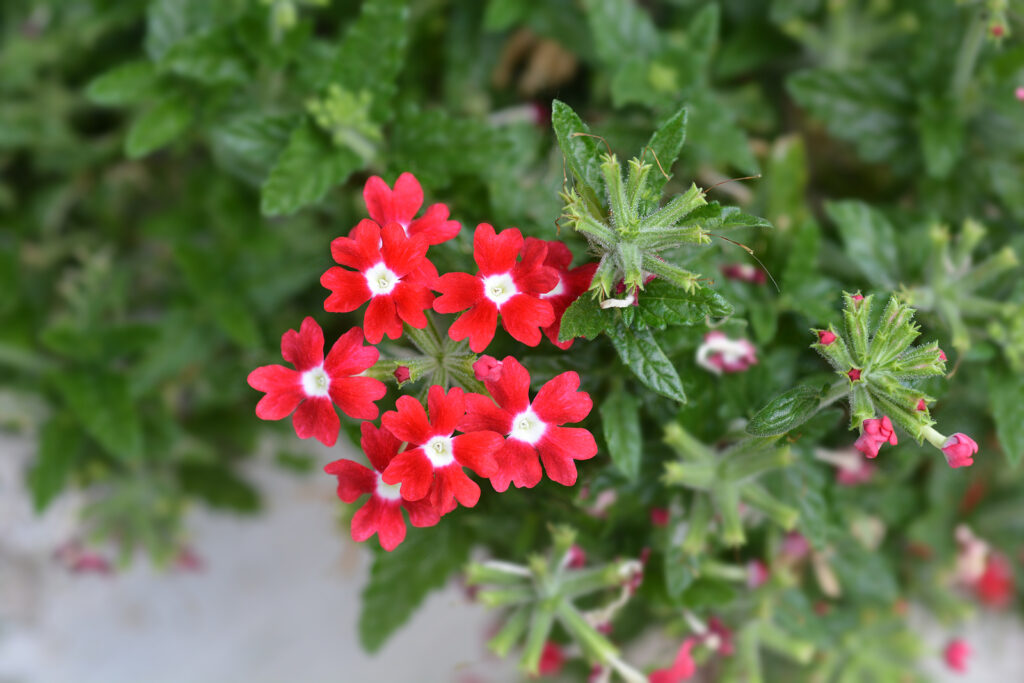
Get to know Verbena hybrids
- Plant type: Perennials, commonly grown as annuals
- Growing Zones and range: Zones 2 to 11 as an annual; Zone 9-11 as a perennial
- Hardiness: Hardy to 10°F (-12°C); tolerant of heat, sensitive to frost
- Height and width: 8 inches (20cm) to 4 feet (1.2m) tall; 16 inches to 4 feet wide depending on the variety.
- Foliage: Usually opposite, toothed, sometimes lobed to pinnatifid leaves
- Flowers: Clusters of small tubular flowers are 2.5 to 4 inches (6-10cm) across; flowers appear in dense, terminal spikes, panicles, cymes, or corymbs.
- Flower colors: White, pale peach, pink, red, yellow, or purple-blue
- Bloom time: Summer to frost
- Uses: Beds, borders
- Common name: Verbena
- Botanical name: Verbena spp.
- Family: Verbenaceae
- Origin: Tropical and temperate regions of North, Central, and South America
Where to plant Verbena
- Grow verbena in full sun in Zones 2-6. Grow verbena in light shade in Zones 7-11.
- Grow verbena in humus-rich to average, well-drained soil.
- Prepare soil outdoors by tilling compost or other organic amendments under 12 inches (30cm) deep.
Verbena uses and companions
- Verbenas are attractive when grouped in beds and borders.
- Trailing cultivars are a good choice as a flowering ground cover or in hanging baskets.
- Good garden companions for Verbena include Achillea ‘Moonshine’, Artemisia, Gaura lindheimeri, Nepeta, Sedum, Senecio, Zauschneria.
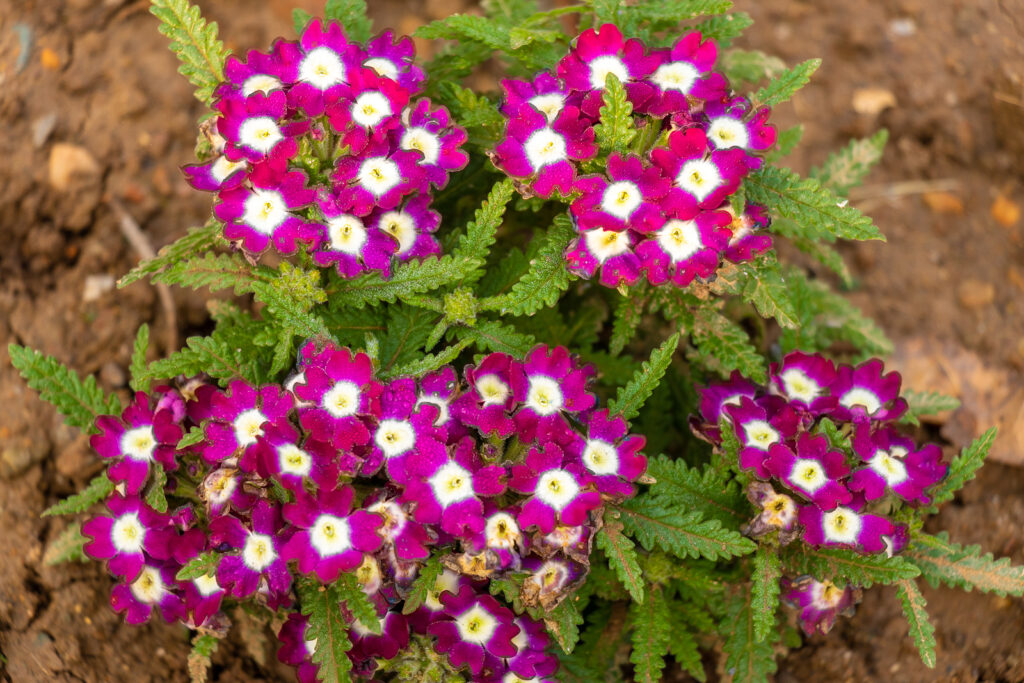
When to plant Verbena
- Set verbena in the garden in spring after all danger of frost has passed.
- Start seed indoors 10 to 12 weeks before the last frost; refrigerate seeds for 7 days before sowing.
- Verbena prefers a soil pH of 5.8 to 7.2.
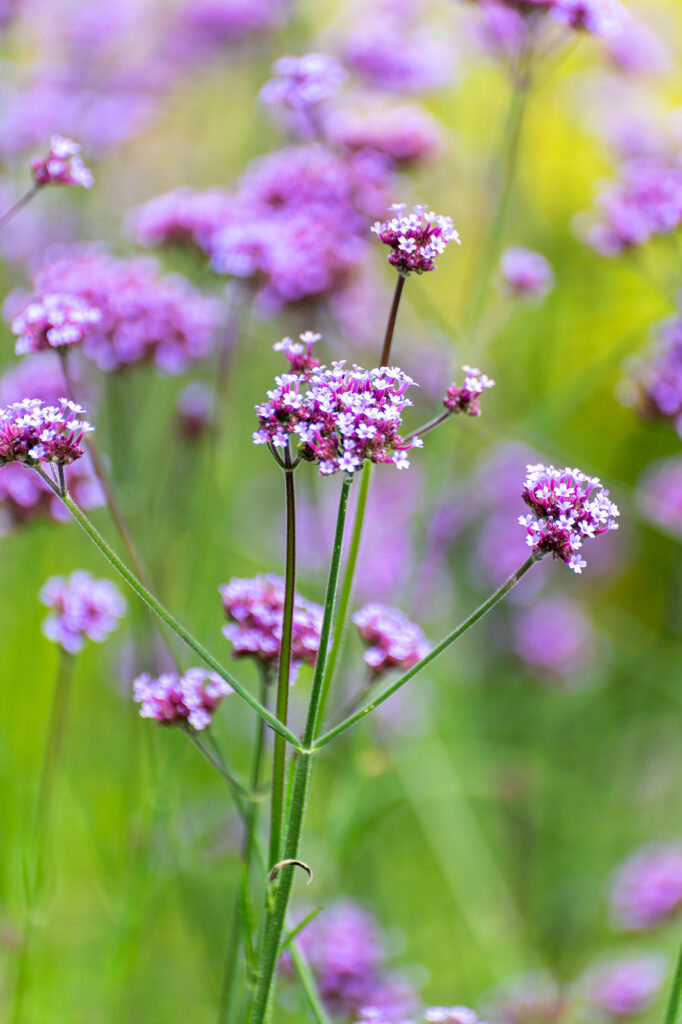
Planting and spacing Verbena
- Refrigerate seeds for 7 days prior to sowing.
- Sow seeds heavily; the germination rate is usually low. Germination takes 20 to 25 days.
- Plant seeds thinly without covering them with soil; keep them warm 70° to 75°F (21°-24°C); keep pots or flats covered with black plastic; seeds need darkness to germinate.
- Germination will be poor outdoors in the garden.
- Grow seedlings in bright sunlight or below fluorescent light.
- Set plants outdoors after all danger of frost has passed, after hardening off seedlings several days in the shade.
- Space verbena 8 inches (20cm) to 4 feet (1.2m) apart depending on the variety.
How to water and feed Verbena
- Verbena needs moderate water; keep the soil evenly moist. Mature plants are drought-tolerant.
- Fertilize verbena every 6 weeks or so with an all-purpose fertilizer.
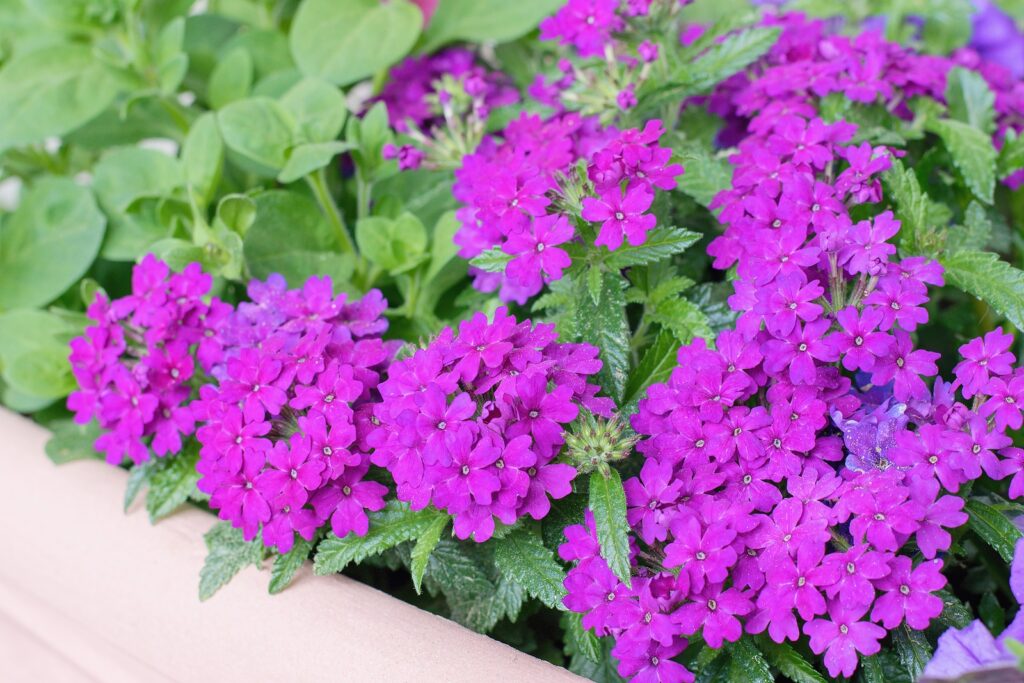
Verbena care
- Mulch around verbena to conserve soil moisture.
- Remove spent blossoms to encourage new blooms.
- Perennial varieties can be cut back by half to two-thirds in spring to keep plants compact and neat.
- Damping-off can attack seedlings; avoid overwatering seedlings.
- Mature plants are susceptible to mildew; avoid wetting the foliage.
Good Products for Seed Starting Success at Amazon:
- Jump Start Germination Station w/Heat Mat Tray, 72-Cell Pack, Dome
- Espoma Seed Starting Mix
- 200 Count- Jiffy 7 Peat Soil Seed Starting Plugs
- Seed Starter Kit with Humidity Dome (120 Cells Total Tray)
- AgrobriteT5 Fluorescent, 2-Foot, Grow Light System
Verbena propagation
- Verbena seeds germinate in 3 to 4 weeks at 50° to 75°F (10°-24°C).
- Take cuttings during summer or fall. Verbena can be grown indoors in winter in a cool greenhouse at 55°F (12.8°C).
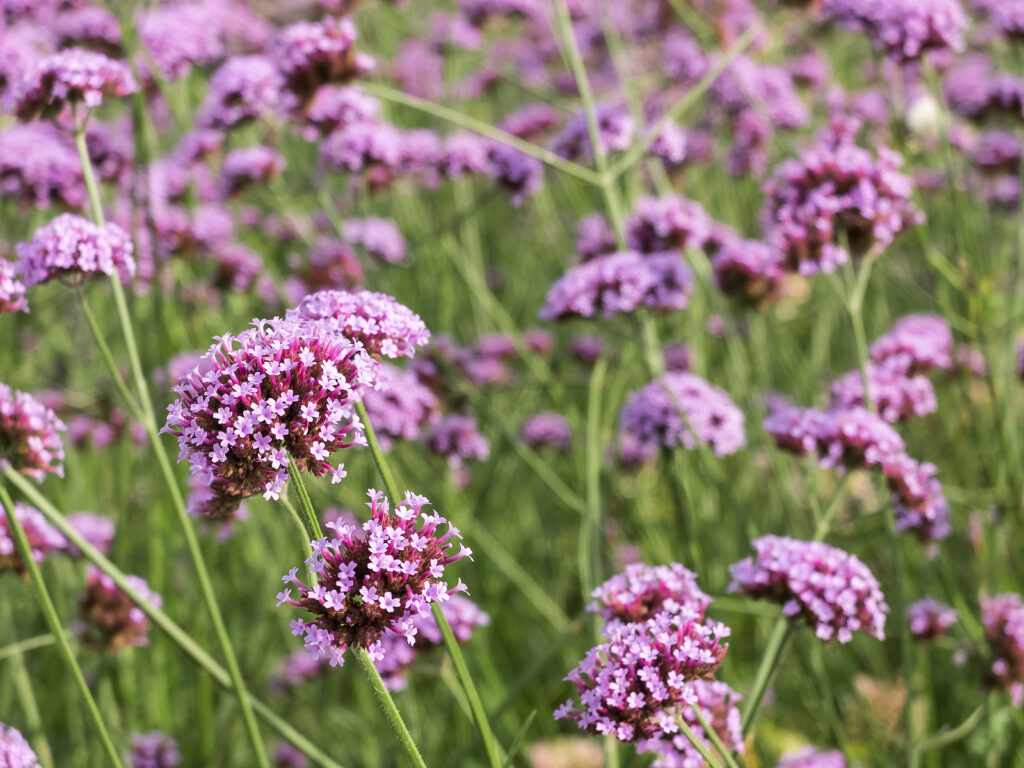
Verbena varieties to grow
- Verbena bonariensis: Annual in Zones 2-6, and perennial in Zones 7-11; the somewhat shrubby plant can grow to 6 feet (1.8m) tall and half as wide; lance-shaped leaves at the base of plant topped by erect branching stems with 2-inch-wide clusters of 1/4-inch wide purple flowers from midsummer to fall; grows best in Zones 7 to 11.
- V. canadensis, rose verbena or clump verbena: Perennial in Zones 6-10; the creeping plant grows to 18 inches (45cm) tall and spreads to 3 feet (.9m); bears a dense rounded cluster of rose-pink flowers in early summer and can bloom sporadically until fall.
- V. hastata, blue vervain: Grows 3 to 5 feet tall with branched 2 to 4-inch wide clusters of violet, purple, or white flowers from early summer to fall.
- Verbena x hybrida, common garden verbena: Tender perennial commonly grown as a warm-season annual; grows to 18 inches (45cm) tall; can be erect and bushy or mat-forming depending on the cultivar; flowers are borne in rounded 3-inch wide clusters from summer to fall in violet, purple-blue, scarlet, rose, red, and white often with a white eye; cultivars include Romance Series, Novalis Series, and ‘Peaches and Cream.’
- V. officinalis, vervain: Perennial grows to 18 inches (45cm) with long, slender spikes of small mauve flowers from midsummer to early autumn.
- V. peruviana (V. chamaedryfolia): Flat-mat growing perennial with flat-topped clusters of scarlet-and-white flowers on slender stems; cultivars have other colored flowers,
- V. rigida, vervain: also listed as V. vernosa: Perennial bears 2-inch wide clusters of fragrant purple or magenta 1/4 inch wide flowers.
- V. ‘Sissinghurst’: Perennial grows a few inches tall and spreads to 4 feet (1.2m) wide with rose-pink flowers.
- V. tenuisecta, cut-leaf verbena: Annual or tender perennial grows to 18 inches (45cm) tall; 3-inch wide clusters of lavender, mauve, purple, lilac-blue, or white flowers from summer to fall.
Verbena frequently asked questions
Q: Can I grow verbena from seed?
A: Verbenas are not easy to grow from seed unless several factors are just right. Sow seeds 10 to 12 weeks before planting outside a few weeks after the last frost. Chill the seeds in the refrigerator for 7 days before sowing. Use a sterile sowing medium and do not overcrowd seedlings or overwater. Keep the temperature at 60°F at night and 70° to 75°F during the day.
Q: When can verbenas go in the garden?
A: Transplant verbenas to the garden a few weeks after the last frost. Be sure to harden off seedlings before setting them outdoors.
Q: What kind of growing conditions do verbenas like outdoors?
A: Grow verbenas in full sun in a light, humus-rich soil that is well-drained. Verbenas are a great choice for hot weather regions. Fertilize the plants monthly with a soluble all-purpose fertilizer.















